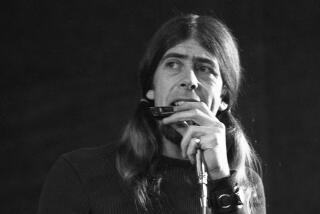Dion Experiments in ‘Bronx Blues’
- Share via
At quick glance, it’s easy to mistake the young man in the early-’60s photo on the back of Columbia Records’ new “Bronx Blues” album for Bobby Darin.
In fact, however, the singer with the sport jacket and open collar shirt is Dion DiMucci, though he had enough in common with Darin at that time to make the similarity in appearance understandable.
Darin and Dion--as DiMucci has usually been billed--were both New Yorkers who scored rock hits in the late ‘50s with such records as “Queen of the Hop” and “A Teenager in Love,” respectively.
But both were such gifted singers that record companies and managers quickly tried to steer them to the “adult pop” world in hopes of building permanent careers before the bottom fell out in rock, which was considered a passing teen fad.
Darin, who had a No. 1 single in 1959 with “Mack the Knife” for Atlantic Records, was signed in the early ‘60s by Capitol Records, which tried to build him into the young Sinatra.
Dion, who also had hits on Laurie Records with such old pop tunes as “Where or When” and “When You Wish Upon a Star,” was signed in 1962 by Columbia Records, also with an eye no doubt on an adult market.
According to Gene Sculatti’s liner notes, a staff producer at Columbia tried briefly to push Dion in a “legit” musical direction, but the company eventually let Dion oversee his own recording sessions.
The 20 selections on “Bronx Blues” reflect Dion’s musical experimentation between 1962 and 1965, reworking favorite old R&B; hits--including “Little Girl of Mine” and “Drip Drop”--as well as updating his old Dion & the Belmonts style with such numbers as “Donna the Prima Donna” and “Flim Flam.”
The retrospective album also contains some blues excursions, including previously unreleased versions of Sonny Boy Williamson’s “Don’t Start Me Talking” and Bob Dylan’s “Baby, I’m in the Mood for You.”
Dion--who, along with Darin, has been voted into the Rock and Roll Hall of Fame--describes his brand of urban blues in an interview with Sculatti for the liner notes:
“Rock ‘n’ roll started as rebellious music. It had an attitude, and in that attitude was a lot of stuff: anger, frustration, joy and that whole sense of really shakin’ things up.
“When it first exploded, it happened in a whole lot of different places at once. In Lubbock, Tex., it was Buddy Holly. In the San Fernando Valley, it was Ritchie Valens. And the brand of it that I made comes from where I come from. That’s why they call it the Bronx blues.”
More to Read
The biggest entertainment stories
Get our big stories about Hollywood, film, television, music, arts, culture and more right in your inbox as soon as they publish.
You may occasionally receive promotional content from the Los Angeles Times.










